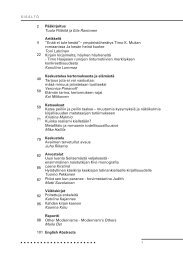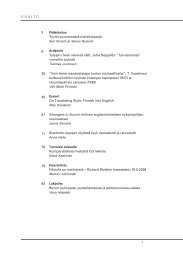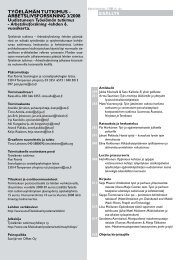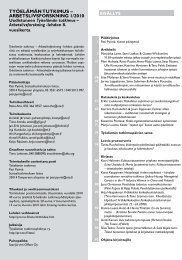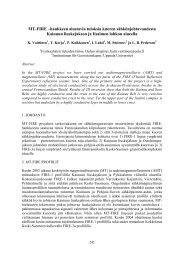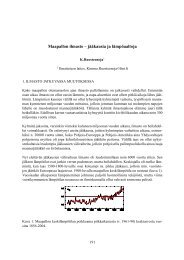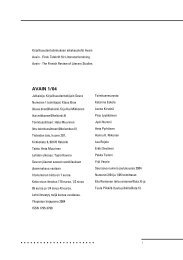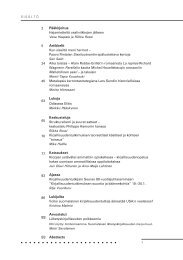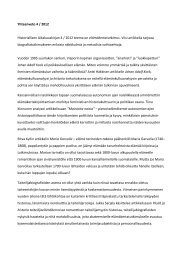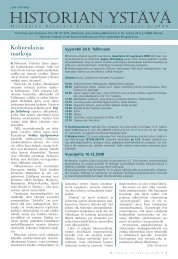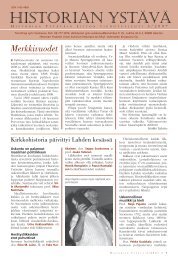Modeling of Martian atmospheric phenomena and atmosphere ...
Modeling of Martian atmospheric phenomena and atmosphere ...
Modeling of Martian atmospheric phenomena and atmosphere ...
Create successful ePaper yourself
Turn your PDF publications into a flip-book with our unique Google optimized e-Paper software.
<strong>Modeling</strong> <strong>of</strong> <strong>Martian</strong> <strong>atmospheric</strong> <strong>phenomena</strong> <strong>and</strong> <strong>atmosphere</strong>-surfaceinteractions at University <strong>of</strong> Helsinki <strong>and</strong> Finnish Meteorological InstituteT. Siili 1 , A.-M. Harri 1 , S. Järvenoja 2 , J. Kauhanen 3 , A. Määttänen 3 <strong>and</strong> H. Savijärvi 31 Finnish Meteorological Institute / Space research, Tero.Siili@fmi.fi2 Finnish Meteorological Institute / Climate <strong>and</strong> global change3 University <strong>of</strong> Helsinki / Atmospheric researchAbstractCollaboration between the University <strong>of</strong> Helsinki (UH) Atmospheric research <strong>and</strong> the FinnishMeteorological Institute (FMI) in modeling <strong>Martian</strong> <strong>atmospheric</strong> <strong>phenomena</strong> <strong>and</strong> <strong>atmosphere</strong>surfaceinteractions has been going on since the early 1990s. This activity has supported theFMI Mars mission participation <strong>and</strong> together therewith has formed a comprehensive Mars’<strong>atmospheric</strong> research effort. For a long time the primary tools have been the 1-D column<strong>and</strong> the 2-D mesoscale model. The Antares funding programme enabled two significant stepsforward: the development <strong>and</strong> implementation <strong>of</strong> the 3-D Mars Limited Area Model <strong>and</strong> work inthe field <strong>of</strong> microphysical <strong>phenomena</strong> related to <strong>Martian</strong> nucleation processes <strong>of</strong> ice crystals.1. INTRODUCTIONMars — the fourth planet <strong>of</strong> our Solar System — is in it perhaps the one most like the Earth. Itslength-<strong>of</strong>-day (24.6 h) <strong>and</strong> inclination <strong>of</strong> the rotational axis (25.19 ◦ ) are very close to terrestrialvalues. Mars is smaller <strong>and</strong> has weaker gravity, it lacks liquid water bodies on its surface <strong>and</strong>due to its outer orbit the year is longer (687 d), but the seasonal variations are highly similar<strong>and</strong> the planet has polar ice caps (composed <strong>of</strong>, however, H 2 O <strong>and</strong> CO 2 ices). The <strong>atmosphere</strong>comprises mostly <strong>of</strong> CO 2 (>95 %), the global mean surface pressure 〈 ¯p s 〉 ≈ 8 hPa, the nearsurface<strong>atmospheric</strong> temperatures are in the 145 K . . . 290 K range. Although Mars’ <strong>atmosphere</strong>is dry in absolute terms, relative humidity can <strong>of</strong>ten reach 100 %. As a result condensationclouds <strong>and</strong> near-surface fogs composed <strong>of</strong> H 2 O ice do occur (e.g., Savijärvi, 1995, 1999).Dust storms <strong>of</strong> varying spatial scales are observed regularly <strong>and</strong> they influence strongly the<strong>atmospheric</strong> heating <strong>and</strong> cooling characteristics.Many climatological <strong>and</strong> meteorological <strong>phenomena</strong> occurring in the <strong>Martian</strong> <strong>and</strong> terrestrial<strong>atmosphere</strong>s are quite similar, with certain important differences. Hence the experience in modelingefforts accumulated <strong>and</strong> developed for terrestrial conditions is applicable after reasonablemodifications for Mars studies. This approach was pioneered in Finl<strong>and</strong> for mesoscale studiesin co-operation between the UH <strong>and</strong> FMI. Despite <strong>of</strong> the similarities, observations are crucial223
to guide <strong>and</strong> validate the models. The basic work has considered parameterization methods forthe physical processes in the <strong>Martian</strong> <strong>atmosphere</strong> (e.g., turbulence, radiative transfer, soil heattransfer, cloud <strong>and</strong> fog physics). The applied work has consisted <strong>of</strong> studies <strong>of</strong> mesoscale <strong>and</strong>planetary boundary layer (PBL) <strong>phenomena</strong> driven by <strong>atmosphere</strong>-surface interactions.FMI’s space research has since mid-1980s had a substantial involvement in Mars missions withspecial emphasis on <strong>atmospheric</strong> investigations. FMI has previously participated in, e.g., theMars 96, Mars Polar L<strong>and</strong>er, NetL<strong>and</strong>er <strong>and</strong> Beagle 2 missions; currently the FMI team isworking on, e.g., the MetNet surface meteorological network concept as well as on the Phoenix<strong>and</strong> Mars Science Laboratory missions. FMI also represents Finl<strong>and</strong> in the International MarsExploration Working Group. The modeling activities <strong>and</strong> the mission involvements togetherform a strong <strong>and</strong> comprehensive Mars <strong>atmospheric</strong> research effort.2. PROCESS STUDIES, PHYSICAL PARAMETERIZATIONS AND THE COLUMNMODELWe have studied the fundamental physical processes <strong>of</strong> the <strong>Martian</strong> <strong>atmosphere</strong> <strong>and</strong> have developedparameterizations for them. A radiative transfer study for the dustless case (Savijärvi,1991b) showed that the effect <strong>of</strong> H 2 O in Mars is generally small. It has so far been left out <strong>of</strong>Mars General Circulation Models (MGCMs), but should be included in the next generation.A column model including a mixing length closure for turbulence <strong>and</strong> simple radiation schemesfor the effects <strong>of</strong> CO 2 , H 2 O <strong>and</strong> dust gave a fairly good simulation for the two Viking L<strong>and</strong>er(VL) sites (Savijärvi, 1991a). The diurnal cycle <strong>of</strong> H 2 O was studied more closely in Savijärvi(1995) with a refined scheme for the thermal diffusion in the soil. Also the preliminaryMPF observations were fairly well simulated (Savijärvi, 1999). With the MPF wind speed datafinally available <strong>and</strong> with a radiation scheme tuned <strong>and</strong> validated against line-by-line (LBL)calculations, the match was even better (Savijärvi et al., 2004; Määttänen <strong>and</strong> Savijärvi, 2004).The shortwave (SW) LBL comparison (Savijärvi et al., 2005) included a general improvementsuggested for the so-called delta-two-stream SW radiation schemes. The improvement reducedthe systematic error <strong>of</strong> these methods by more than 50 %. It can be applied in Earth GCMschemes as well. The improved method was then used to study the “anti-greenhouse” effect<strong>of</strong> the <strong>Martian</strong> dust on its climate as the function <strong>of</strong> dust amount <strong>and</strong> dust optics. A Marsintercomparison <strong>of</strong> radiation codes is now an ongoing worldwide project lead by UH <strong>and</strong> FMI.In this project, all the main Mars GCM codes are being compared against the first-principlesLBL results in fixed reference conditions.Presently the temperature pr<strong>of</strong>iles from the thermal emission spectrometers (mini-TES) onboardthe Mars Exploration Rovers (MER) are being studied by the group, <strong>and</strong> compared with modelcalculations. These pr<strong>of</strong>iles appear to indicate strong daytime convection above the radiativelyheated surface layer, as predicted by the column model.224
3. THE 2-D MESOSCALE MODELThe 2-D Mars Mesoscale Circulation Model (MMCM) is in a way an extension <strong>of</strong> <strong>of</strong> the 1-Dcolumn model, as the 2-D model adds a horizontal dimension representing a “slice” <strong>of</strong> the <strong>atmosphere</strong>.The limited spatial dimensionality brings with it inherent limitations — the area understudy <strong>and</strong> simulation has to exhibit only moderate or small variations in the most significantvariables in the direction perpendicular to the computational grid.The 2-D MMCM is based on a terrestrial research model. The Mars version was created alreadyin the early 1990s. It has subsequently been developed further <strong>and</strong> used to study primarily socalledsurface-induced circulation <strong>phenomena</strong>, such as slope winds (Savijärvi <strong>and</strong> Siili, 1993),circulations driven by horizontal thermal contrasts caused by variations in surface propertiessuch as albedo, thermal inertia (Siili, 1996), ice (CO 2 <strong>and</strong>/or H 2 O) cover (Siili et al., 1997)as well as combinations there<strong>of</strong>. In the recent years <strong>phenomena</strong> in the <strong>Martian</strong> polar regionshave been <strong>of</strong> primary interest. Consequently H 2 O condensation, sublimation <strong>and</strong> transport (horizontaladvection, vertical diffusion) processes have been incorporated into the model, the approachis essentially as described by Savijärvi (1995).Since <strong>atmospheric</strong> modelling is sensitive to initial conditions, ensemble or statistical type approacheshave been investigated for <strong>and</strong> even introduced to terrestrial models to some degree.In these approaches a forecast is arrived at by running a set <strong>of</strong> simulations with varied initial orboundary conditions <strong>and</strong> analysing the set <strong>of</strong> results using statistical methods. The robustness<strong>of</strong> these approaches is mitigated by the high computational cost. Due to its reasonable computationalcost the we have used our 2-D model in a pilot study <strong>of</strong> Mars ensemble simulations.4. THE MARS LIMITED AREA MODELThe Mars Limited Area Model (MLAM) is a spatially fully 3-D MMCM <strong>and</strong> is based on thedynamical core <strong>of</strong> the widely (also by FMI) used operational weather forecast model HIRLAM(HIgh Resolution Limited Area Model), v. 5.0.0. As with the 1-D <strong>and</strong> 2-D models earlier,planetary constants <strong>and</strong> parameterizations (the “physics”) appropriate for Mars have replacedthe terrestrial values <strong>and</strong> schemes. A limited area model needs also realistic initial <strong>and</strong> boundaryconditions; they were taken initially from the European Mars Climate Database <strong>and</strong> currentlysimulation results <strong>of</strong> the Oxford University’s MGCM are used. Results from other MGCMscould also be used in the future. Our model system is hence the first European 3-D MMCM.The MLAM results have been tested <strong>and</strong> compared against the 1-D <strong>and</strong> 2-D <strong>and</strong> other 3-DMMCM model results as well as VL, MPF <strong>and</strong> most recently MER Mini-TES observations.VL1 <strong>and</strong> MPF diurnal temperature cycles <strong>and</strong> wind fields are reproduced very well. An example<strong>of</strong> the results is shown in Figure 1. The 3-D nature <strong>of</strong> the model has also enabled more realisticsimulations <strong>of</strong> Hellas impact basin summertime circulations. We are also planning MER simulationsusing data <strong>of</strong> the Mars Global Surveyor/Thermal Emission Spectrometer instrumentassimilated with the Oxford MGCM as initial <strong>and</strong> boundary conditions for the MLAM.225
Figure 1: A MLAM forecast <strong>of</strong> ground temperature (greyscale; in K) <strong>and</strong> 1.5 m level winds(arrows; in m/s; the arrow below the image denotes 20 m/s) over topography (contours; in mfrom Mars’ lowest elevation) in the VL1 <strong>and</strong> MPF l<strong>and</strong>ing region (the l<strong>and</strong>ing sites are markedwith “VL1” <strong>and</strong> “MPF”). Season is summer solstice (L s = 90 ◦ ) <strong>and</strong> local time is 1100 at 0 ◦ W(0900 at 30 ◦ W — the MPF longitude).5. AEROSOL PROCESSESBesides dust, also ice crystals are frequently observed in the form <strong>of</strong> clouds in the <strong>Martian</strong> <strong>atmosphere</strong>.We have studied their formation processes in <strong>Martian</strong> conditions, <strong>and</strong> compared withobservations <strong>and</strong> previous modelling results. The situation in the <strong>Martian</strong> <strong>atmosphere</strong> differsfrom the terrestrial conditions, since the <strong>atmosphere</strong> is nearly pure CO 2 vapour, which takespart in the processes <strong>of</strong> particle formation (nucleation) <strong>and</strong> subsequent growth. In a near-puresituation nucleation becomes non-isothermal <strong>and</strong> strong coupling <strong>of</strong> fluxes arises in multicomponentcondensation. These effects need to be taken into account in the theories used.We studied homogeneous <strong>and</strong> heterogeneous nucleation <strong>of</strong> CO 2 based on the work by Wood(1999), <strong>and</strong> H 2 O nucleation following the same schemes. We have compared the results to CO 2laboratory measurements (Gl<strong>and</strong>orf et al., 2002). The H 2 O results were compared to those <strong>of</strong>Inada (2002). A more detailed description can be found in Määttänen et al. (2005). On Mars,homogeneous nucleation would require very high saturation ratios (10 8 ). Anyhow, the onsetsaturation ratio (the saturation ratio for nucleation rate <strong>of</strong> 1 s −1 ) <strong>of</strong> heterogeneous nucleation forCO 2 on dust particles <strong>of</strong> 1.0 µm radius is 1.32. This is in fair agreement with measured values(Gl<strong>and</strong>orf et al., 2002). For constant concentration <strong>of</strong> CO 2 it gives a threshold temperature <strong>of</strong>145 K. For water with average concentration <strong>of</strong> 300 ppm the onset saturation ratio would be1.18 <strong>and</strong> the corresponding threshold temperature 200 K (Figure 2).We have modelled nucleation as a function <strong>of</strong> height at different locations, e.g., the MPF l<strong>and</strong>ing226
site, <strong>and</strong> compared the results with observations. Here the nucleation model predicted H 2 Onucleation in a slightly thinner (40 m) layer than the 1D model (80 m). This is related to thehigher threshold saturation ratio calculated by the nucleation model (1.18 vs. 1.0) restrictingnucleation to happen closer to the surface. The model results are in good agreement with eachother <strong>and</strong> observations (Sch<strong>of</strong>ield et al., 1997). In the Memnonia region, where surface fog wasobserved by the Viking Orbiter 1 (Briggs et al., 1977), the model shows clear H 2 O nucleationthroughout the night reaching up to the height <strong>of</strong> 100 m. This result agrees with the modelresults <strong>of</strong> Inada (2002). The model predicted nucleation also higher in the <strong>atmosphere</strong>, whenusing the unmodified l<strong>and</strong>ing pr<strong>of</strong>ile <strong>of</strong> the MPF. Our nucleation results agree well with thecloud model results <strong>of</strong> Colaprete et al. (1999) at 55 km <strong>and</strong> below.Work on modelling binary nucleation <strong>of</strong> CO 2<strong>and</strong> H 2 O has been started. We assume anideal mixture <strong>of</strong> CO 2 <strong>and</strong> H 2 O as a first approximationwhich will be tested <strong>and</strong> improvedin later phases <strong>of</strong> the study. The originalmodel (Noppel et al., 2002) does not includeheterogeneous nucleation which needs to beadded to the model. Both homogeneous <strong>and</strong>heterogeneous results will be presented in thenear future.Nucleation rate (s −1 )1e+251e+201e+151e+1010000011e−05J for H 2 OJ for CO 21e−10100 120 140 160 180 200Temperature (K)6. CONCLUSIONSAND FUTURE PROSPECTSFigure 2: Heterogeneous nucleation rates forH 2 O <strong>and</strong> CO 2 in the <strong>Martian</strong> <strong>atmosphere</strong>.The UH-FMI joint Mars <strong>atmospheric</strong> modelling activity has given rise to a consortium withexceptional expertise in micro- <strong>and</strong> mesoscale dynamical modelling — especially on nationalarena, yet with very good st<strong>and</strong>ing internationally as well. Our group develops <strong>and</strong> uses thecurrently only European MMCM <strong>and</strong> has in that context a good working relationship with theEuropean modelers <strong>of</strong> <strong>Martian</strong> global scale <strong>phenomena</strong>. The aerosol microphysics researchfeeds back in a natural way into the dynamical modelling studies. The modelling effort isstrongly enhanced by the close <strong>and</strong> tight links via FMI with work on in situ observations <strong>of</strong>both micro-, meso- <strong>and</strong> macroscale <strong>phenomena</strong> <strong>of</strong> the <strong>Martian</strong> <strong>atmosphere</strong>. Future plans includeexp<strong>and</strong>ed <strong>and</strong> new collaboration (national <strong>and</strong> international) with other groups in the areas <strong>of</strong>optical properties <strong>of</strong> aerosols, <strong>atmospheric</strong> remote sensing as well as <strong>atmospheric</strong> transport<strong>phenomena</strong>.REFERENCESBriggs, G., K. Klaasen, T. Thorpe <strong>and</strong> J. Wellman, 1977. <strong>Martian</strong> dynamical <strong>phenomena</strong> duringJune-November 1976: Viking Orbiter imaging results. J. Geophys. Res., 82, 4121–4149.227
Colaprete, A., O. B. Toon <strong>and</strong> J. A. Magalhães, 1999. Cloud formation under Mars Pathfinderconditions. J. Geophys. Res., 104, E4, 9043–9053.Gl<strong>and</strong>orf, D. L., A. Colaprete, M. A. Tolbert <strong>and</strong> O. B. Toon, 2002. CO 2 snow on Mars <strong>and</strong>early Earth: experimental constraints. Icarus, 160, 66–72. doi:10.1006/icar.2002.6953.Inada, A., 2002. Simulations <strong>of</strong> <strong>Martian</strong> Surface Fog <strong>and</strong> Calibration <strong>of</strong> Mars Imaging Camerafor its Future Observations. Ph.D. thesis, Kobe University.Määttänen, A. <strong>and</strong> H. Savijärvi, 2004. Sensitivity tests with a one-dimensional boundary-layerMars model. Boundary-Layer Meteorol., 113, 305–320.Määttänen, A., H. Vehkamäki, A. Lauri, S. Merikallio, J. Kauhanen, H. Savijärvi <strong>and</strong> M. Kulmala,2005. Nucleation studies in the <strong>Martian</strong> <strong>atmosphere</strong>. J. Geophys. Res., 110, E2,E02002. doi:10.1029/2004JE002308.Noppel, M., H. Vehkamäki <strong>and</strong> M. Kulmala, 2002. An improved model for hydrate formationin sulfuric acid-water nucleation. J. Chem. Phys., 116, 218–228.Savijärvi, H., 1991a. A model study <strong>of</strong> the PBL structure on Mars <strong>and</strong> the Earth. Contrib.Atmos. Phys., 64, 219–229.Savijärvi, H., 1991b. Radiative fluxes on a dustfree Mars. Contrib. Atmos. Phys., 64, 103–112.Savijärvi, H., 1995. Mars boundary layer modelling: diurnal moisture cycle <strong>and</strong> soil propertiesat the Viking L<strong>and</strong>er 1 site. Icarus, 117, 120–127.Savijärvi, H., 1999. A model study <strong>of</strong> the <strong>atmospheric</strong> boundary layer in the Mars Pathfinderl<strong>and</strong>er conditions. Q. J. R. Met. Soc., 125, 483–493.Savijärvi, H. <strong>and</strong> T. Siili, 1993. The <strong>Martian</strong> slope winds <strong>and</strong> the nocturnal PBL jet. J. Atmos.Sci., 50, 77–88.Savijärvi, H., D. Crisp <strong>and</strong> A.-M. Harri, 2005. Effects <strong>of</strong> CO 2 <strong>and</strong> dust on present-day solarradiation <strong>and</strong> climate in Mars. Q. J. R. Met. Soc. Accepted for publication.Savijärvi, H., A. Määttänen, J. Kauhanen <strong>and</strong> A.-M. Harri, 2004. Mars Pathfinder: new data<strong>and</strong> new model simulations. Q. J. R. Met. Soc., 130, 597, 669–683.Sch<strong>of</strong>ield, J. T., J. R. Barnes, D. Crisp, R. M. Haberle, S. Larsen, J. A. Magalhães, J. R.Murphy, A. Seiff <strong>and</strong> G. Wilson, 1997. The Mars Pathfinder Atmospheric Structure Investigation/Meteorology(ASI/MET) experiment. Science, 278, 1752–1758.Siili, T., 1996. <strong>Modeling</strong> <strong>of</strong> albedo <strong>and</strong> thermal inertia induced mesoscale circulations in themidlatitude summertime <strong>Martian</strong> <strong>atmosphere</strong>. J. Geophys. Res., 101, 14957–14968.Siili, T., R. M. Haberle <strong>and</strong> J. R. Murphy, 1997. Sensitivity <strong>of</strong> <strong>Martian</strong> southern polar cap edgewinds <strong>and</strong> surface stresses to dust optical thickness <strong>and</strong> to the large-scale sublimation flow.Adv. Space Res., 19, 1241–1244.Wood, S. E., 1999. Nucleation <strong>and</strong> Growth <strong>of</strong> CO 2 Ice Crystals in the <strong>Martian</strong> Atmosphere.Ph.D. thesis, University <strong>of</strong> California.228




